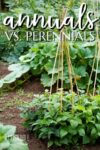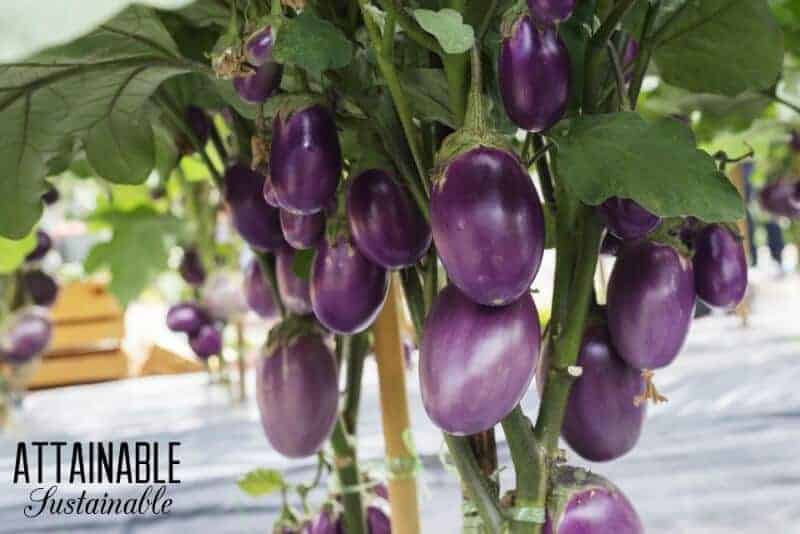Annuals vs. perennials — what exactly are each of these types of plants? If you’re a novice gardener, thumbing through seed catalogs and feeling completely overwhelmed, wondering what the heck the difference is between annuals and perennials, this is for you.
Originally published in February 2019; this post has been updated.
Vegetables for your garden come in all shapes and sizes. (For that matter, flowers do, too, but we’ll stick to annuals vs. perennials in the vegetable realm here.)
Annuals vs. Perennials
- An annual plant lives for one growing season and then it’s done.
- Perennial plants grow for more than one season.
Some perennials are considered “tender perennials’ and won’t survive a cold winter; those are the vegetables most of us plant fresh each year, treating them as an annual. There are places in the world where these tender perennials can last for more than one season, though.
Within those categories, there are a variety of different types of vegetable plants. Which you choose to plant can help your make the most of your space. Annuals and perennials can thrive side-by-side in your garden.
New to gardening? Limited on space? The 5-Gallon Garden gives you the skills you need to grow food in the space you have. Get started with your garden today!
Grow Some Greens!
Ready to grow fresh greens, no matter WHERE you live? Sign up for my
FREE quick-start guide and start growing some of your own food!
Biennial Vegetables
Some crops aren’t annuals OR perennials, though.
Biennial vegetable crops are plants that have a two-year life cycle. In the first year, the plant grows vegetatively, producing leaves and stems but not fruit or flowers. In the second year, the plant undergoes a process called vernalization, which triggers the formation of flowers and ultimately fruit or seeds.
Celery is a good example of a biennial crop. It grows throughout its first year, allowing you to harvest ribs as you need them. It can overwinter in many regions, and in the second year it will complete it’s life cycle by flowering and going to seed.
Many biennial vegetables are grown as annuals, with the crop being harvested before the seed production cycle has a chance to begin. I’m listing those below, under the label of annuals. Beets, for instance, are harvested in their first year, but wouldn’t produce seeds until the second year.
Annual Plants (and Tender Perennials)
Just like the annual flowers you add to patio pots to bloom during the summer months, annual vegetable plants grow for just one season.
You’ll plant these in your garden—either as seeds or transplants—every year, most often in the springtime (though, yes, fall planting can happen for some of these, too).
Some plants that are technically biennial crops are grown as annuals.
Once and Done Annual Vegetables
These are the plants that you sow, grow, and harvest in their entirety. In other words, in order to harvest the crop you pull the entire plant.
- Radishes reach maturity very quickly. Plant some early; you’ll pull them and be able to use that space for another annual spring crop. The leaves are edible, too! Try making a radish leaf salad dressing or radish leaf pesto.
- Carrots can be hard to get started in the garden; try my grandpa’s trick for better success.
- Beets are so much better fresh than canned. Use the leaves, too!
- Onions are generally planted in the fall and overwintered. They take a fair amount of space and a longer growing season than a lot of annual vegetables, but nothing compares to a homegrown onion.
- Garlic grows similarly to onions. Your location will dictate whether hard neck or soft neck garlic does best.
- Sweet potatoes are dug up once the plant flowers. Those of us in warmer climates can tuck the vines right back into the ground to get another crop started. The sweet potato leaves are edible, too.
- Head lettuce, like the iceberg lettuce you see in the produce section of the supermarket, is harvested by cutting the head off at the base.
Cut and Come Again Annual Vegetables
As the name implies, you can cut—or harvest—a portion of these annuals without harvesting the entire plant (as you can many perennials).
- Lettuce grows as a head or loose leaf. Unless you’re aiming for a perfect head, you can continuously harvest leaves until the plant goes to seed.
- Kale grows taller and taller as you harvest leaves, so this annual can last for months in the garden, offering an ongoing source of food. It’s good for container gardening, too.
- Swiss chard is harvested similarly to celery. Cut the outer stalks and use the leaves and the ribs. One of the easiest vegetables to grow, it also works well in a pot.
- Green onions can be a source of flavor almost all season long. Just snip off the larger stalks and leave the more immature ones in place.
- Spinach and bok choy are two different kinds of greens (both annuals) that offer up the option of cooked or fresh greens. Simply cut the outer leaves as you need them.
- Purslane is considered a weed by many, but it’s a great addition to salads. Just snip off branches as you need them.
- Broccoli is a borderline cut and come again vegetable. Harvest the main head, leaving the plant intact and you’ll find that smaller side shoots develop.
- Cilantro goes to seed quickly, but it’s easy to grow. Harvest by simply cutting off stems a few inches above the ground. New growth will follow.
- Basil just keeps coming during the hot summer months. Pinch leaves off from the tips as you need them.
- Potatoes aren’t exactly cut and come again, but you can carefully dig under the plants to harvest small “new potatoes” before the plant is ready to be pulled and the potatoes harvested.
Continual Harvest Annual Vegetables
These plants typically spend many months in your garden. Once they start putting out fruit, you’ll be able to harvest fruit from the same plant for an extended time.
- Tomato plants take 50-60 days to start providing fruit, but once they do, they tend to be prolific. Determinate plants are smaller bush tomatoes, with fruit ripening within a one to two week window. Indeterminate varieties are more vine-like and continue setting fruit until frost.
- Peppers. Whether you like ’em hot or sweet, they’ll put out fruit all season long. In warmer climates, peppers can be overwintered (or try bringing yours inside), but they are most often considered an annual crop, not a perennial. They’re what’s referred to as a “tender perennial.”
- Summer squash will provide you with an abundance of food from a single plant. Harvest daily to avoid oversized fruit.
- Eggplant comes in a variety of shapes and sizes and colors and the harvest lasts for months.
- Cucumbers grow on vining plants that can take up a fair amount of space. But like summer squash, harvest the fruit almost daily. Pickle time!
- Green beans and peas come in bush and pole varieties (both are annuals). Bush varieties do not need support and take up less space. Both kinds will produce for at least a couple of months if conditions are good.
- Rat tail radish keeps on giving. Instead of pulling up a plant and getting one radish, this plant produces green pods. Bite into one and you’ll get the surprising taste of … radish. Admittedly, this does take up more space in the garden than a single radish, but you’ll be able to chop these flavorful seed pods into your salad for months with just a single plant.
- Tomatillos, also called husk tomatoes, are a heat tolerant crop that can be used to make salsa or chile verde.
Perennial Vegetables
Unlike annual veggies, these crops will keep on giving. Perennials live a longer life cycle than one-season veggies, making them a great addition to your garden design. That’s right, you can tuck a lot of these productive plants right into your landscape as part of your home improvement efforts and nobody will be the wiser.
Adding vegetables that will produce over the course of many years is a no-brainer if you’ve got the space. When comparing annuals vs. perennials, the time savings that comes from perennial plants is a strong mark in favor of planting perennials. Plant them once, harvest for years. [Read more about perennial vegetables here.]
The most important thing to consider here is preparing your soil — these plants will be in the same spot for years; make sure they’ve got a good, rich soil so they thrive.
- Artichokes have been hit or miss for me in the garden, but in my current garden, they’re thriving.
- Asparagus is a perennial that needs two to three years in the ground before you’ll get any kind of crop. Once you do, you’ll be amazed at how easy it is and how good fresh out of the ground asparagus is.
- Rhubarb is one of those old fashioned perennials that grandmas always have in their garden. The leaves are poisonous; use the sour stalks in rhubarb pie or jam. Or make this rhubarb coffee cake.
- Husk cherries might be considered by some to be a shrub, but I find they’re usually spent after a year or two. With fruit in husks similar to a tomatillo, insects are usually not a problem.
- Strawberries are a fruit, of course, but they can be a great addition to your veggie patch and will fruit for several years.















